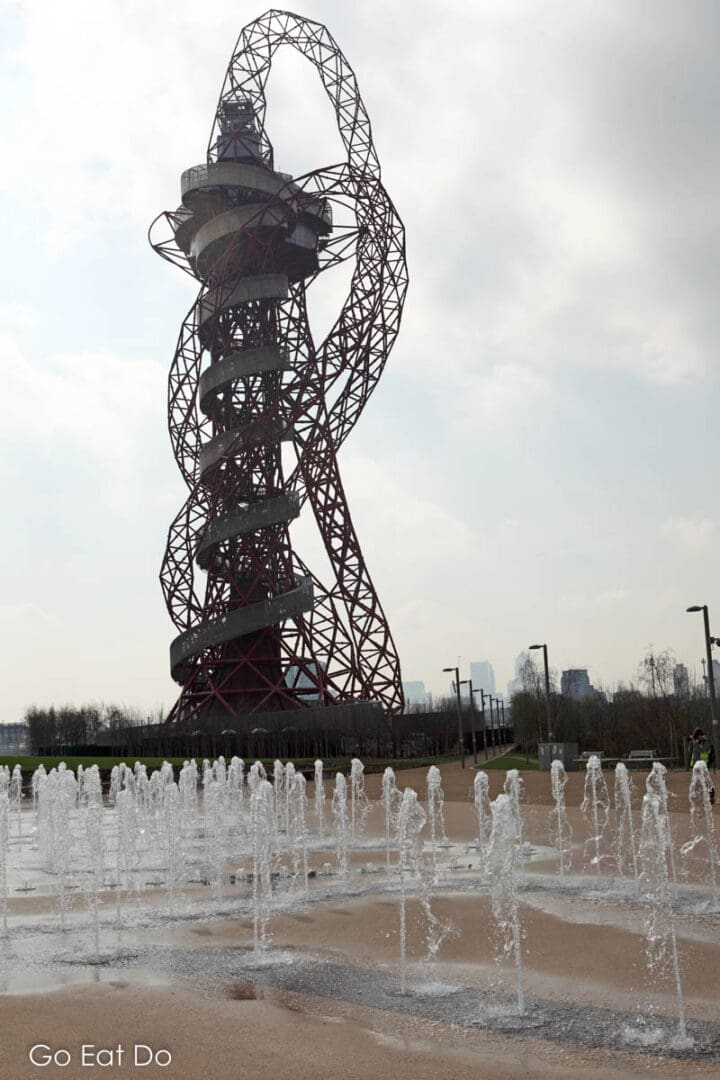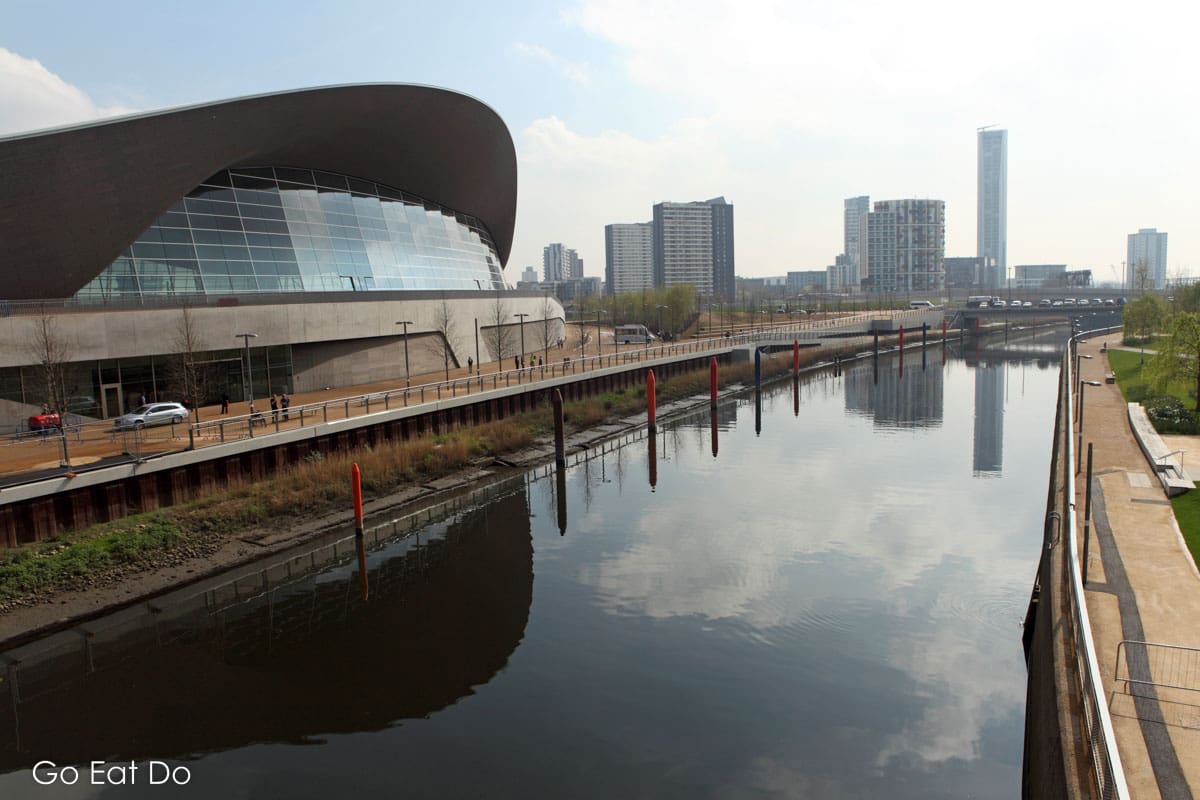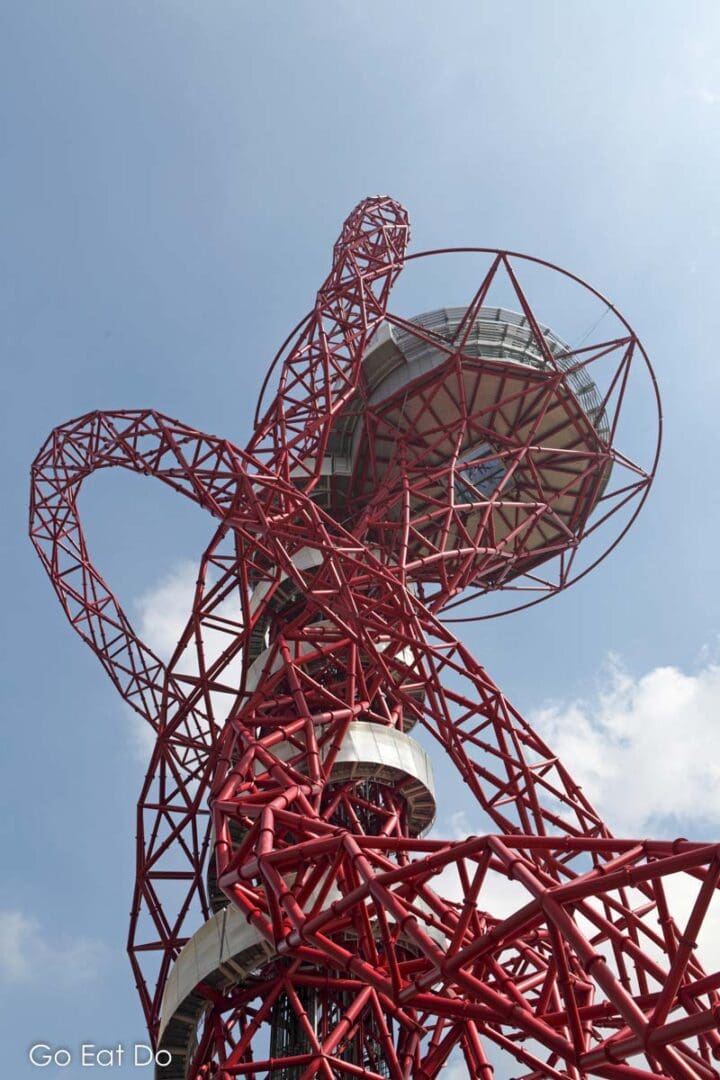Stuart Forster looks at what visitors can expect at the Queen Elizabeth Olympic Park in London, the venue of the 2012 London Olympics, and views Britain’s capital from the ArcelorMittal Orbit.
London hosted the Games of the XXX Olympiad from 27 July to 12 August 2012. A decade after London 2012, the park that hosted the majority of events continues to draw visitors and host sporting events.
Disclosure: Some of the links below and banners are affiliate links, meaning, at no additional cost to you, I will earn a commission if you click through and make a purchase.
It’s a sunny, slightly hazy day in London. From my position on the ArcelorMittal Orbit’s viewing platform, 80 metres (262 feet) above the Queen Elizabeth Olympic Park, I can see the horizon 20 miles away.

London Stadium
Before heading to the lower viewing platform, at a height of 76 metres (249 feet), I photograph the city skyline and take a look towards the stadium that hosted the opening and closing ceremonies of the 2012 London Olympics.
Now known as the London Stadium, it is the home to UK Athletics and West Ham United Football Club. The Hammers moved to the 60,000-seat arena at the start of the 2016-2017 football season.
The stadium hosted games during the 2015 Rugby World Cup and was the venue of the 2017 IAAF World Athletics Championships. Major League Baseball has been played there too.

Queen Elizabeth Olympic Park
With an area of 560 acres (nearly 266 hectares), the Queen Elizabeth Olympic Park is huge. That area equates to around the combined size of London’s Hyde Park and Kensington Gardens.
The park is free to visit and is home to five themed trails, including the 7.5-kilometre (4.7-mile) Legacy Trail, launched in 2022. The accessible trail celebrates the legacy of the 2012 Olympics. Visitors are encouraged to snap photos by the 12 picture frames that have been set up in the park and post them to @queenelizabetholympicpark on social media #london2012 hashtag.
The London 2012 trail, Children’s Adventures in the Park trail, Park and Wildlife trail and Art in the Park trail have been established longer.
The latter, for example, provides information about London 2012 and the area’s biodiversity. The park’s hedgerows and 15 acres of woodland provide habitat to wildlife. Queen Elizabeth Olympic Park has 150 bat boxes and 525 bird boxes. Chaffinches, reed buntings and goldfinches number among the bird species that you might spot while walking in the park.

Canal walks in London
I overhear one of the tower’s employees talking about the waterways below. I always associate London primarily with the River Thames but it’s the River Lea, City Mill River and Waterworks River that cut through the city’s Stratford area.

The sleek curves of the London Aquatics Centre, designed by Zaha Hadid, reflect the afternoon sunlight. A swim at the venue of the Olympic swimming and diving championships is reasonably priced. Pre-booking is recommended.
Prior to taking the lift to the top of the ArcelorMittal Orbit, I popped in to take a look at the 50-metre pool, gym and impressive diving facilities. A member of staff informed me that I missed seeing Olympic medallist Tom Daley by a just couple of minutes.

Visiting the ArcelorMittal Orbit
The ArcelorMittal Orbit, designed by Sir Anish Kapoor and Cecil Balmond, stands 114.5 metres (373 feet) high. It is the UK’s tallest sculpture. From it, I can see London landmarks including the Shard, the Gherkin and St Paul’s Cathedral. This, I’m told, is the only observation tower that looks into London from the east.
The spiralling red tower cost £22.3 million to construct. The lion’s share of that came from Lakshmi Mittal of the steel-producing company ArcelorMittal. I hear how 35,000 bolts were used by the four-man team that constructed the ArcelorMittal Orbit. Of its 2,000 tonnes of steel, around 60 per cent was recycled.
Visitors stare at their distorted reflections in a huge, concave mirror that also helps brighten the lower viewing platform. The shapes of people shift and change as I move my position. People laugh at the mirror’s effect and try to capture the effect on their smartphone cameras.
The ArcelorMittal Orbit is the site of the world’s longest tunnel slide. It is 178 metres (584 feet) long and finishes in a corkscrew. Carsten Höller, a German artist, designed the ArcelorMittal Orbit slide.

Lee Valley VeloPark
Lee Valley VeloPark stands on the far side of the park, over the River Lee. It was the first venue in the world to offer BMX, track, road and mountain biking facilities.
As I cross an area with dancing fountains, I note that the Queen Elizabeth Olympic Park is a popular family-friendly venue. It has a sizable children’s play area with slides and climbing frames. The ground is made of a spongy material that reminds me of the surface of an athletics track, protecting youngsters from injuries such as scraped knees ArcelorMittal Orbit – something that was a perennial problem during my childhood.
Down at Carpenters Road Lock, I spend a few minutes sitting quietly, looking in vain for the kingfisher that I’m told has made its home here.
Over the coming years, this part of London looks set to grow. Five new neighbourhoods, with up to 10,000 homes, are planned by 2030. In the meantime, the Queen Elizabeth Olympic Park is attracting locals, day trippers and sporty types.

Queen Elizabeth Olympic Park map
The map below shows Queen Elizabeth Olympic Park in east London. Zoom into the map to see details and out to view the park’s location in east London.
Travel to Queen Elizabeth Olympic Park
Interested in how to get to Queen Elizabeth Olympic Park? It makes sense to travel by public transport. Stratford, Stratford International and Hackney Wick stations make the park accessible by Dockland Light Railway, Underground, Overground and rail services. The Transport for London website provides information about fares and services.
Bus number 388 (running between London Bridge and Stratford City) stops near the Copper Box Arena and Here East. The 308 stops close to Lee Valley VeloPark. London Aquatics Centre is served by buses 339 and 108. Again, see the Transport for London website for information about the network, fares and services.
Cycle to London’s Olympic Park for the city centre on the Barclays Cycle Superhighway.
Are you considering driving to the London Olympics park? Queen Elizabeth Olympic Park parking is available only for visitors to the venues within the park, including the London Aquatics Centre and Copper Box Arena, which has a multi-storey car park. If you are not visiting those venues, fines apply for using the car parks.
Hotels near Queen Elizabeth Olympic Park
Interested in hotels near London Stadium and the Queen Elizabeth Olympic Park? Search and book hotels in London via the HRS website:
Books about London and the Olympics
Keen to know more about London and the Olympic Games? You can buy the following from Amazon by clicking on the links or cover photos:
London 2012: The Greatest Show on Earth:






Further information
See the Queen Elizabeth Olympic Park website to find out more about attractions including the Copper Box Arena multi-purpose indoor sports venue with a gym, Lee Valley VeloPark and the Lee Valley Hockey and Tennis Centre.
The ArcelorMittal Orbit (tel. +44 (0) 333 8008099) website has information about the iconic landmark that is Britain’s highest sculpture. It also has details about opening times and tickets for Skyline Views and riding the Slide at ArcelorMittal Orbit.
For more information about attractions in England’s capital city see the Visit London website.
Stuart Forster, the author of this post, is an award-winning travel writer and photographer from northeast England.
Thank you for visiting Go Eat Do and reading this post about the Queen Elizabeth Olympic Park in London. Planning a trip to London? You may also enjoy posts about the fun opportunity to be a West End Star for a Day in London and a food tour of London’s East End.
If you enjoyed this post why not sign up for the free Go Eat Do newsletter? It’s a hassle-free way of getting links to posts on a monthly basis.
‘Like’ the Go Eat Do Facebook page to see more photos and content.
A version of this post was initially published on Go Eat Do on 12 October 2014.




